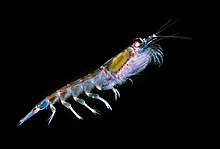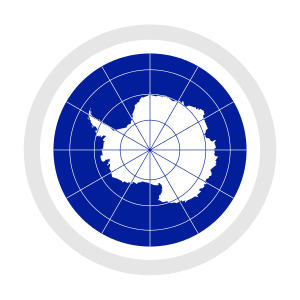Antarctic


The Antarctic (/ænˈtɑːrtɪk/ or /ænˈtɑːrktɪk/, American English also /æntˈɑːrtɪk/ or /æntˈɑːrktɪk/; commonly /æˈnɑːrtɪk/)[Note 1] is a polar region around Earth's South Pole, opposite the Arctic region around the North Pole.
The Antarctic comprises the continent of
Biogeographically, the Antarctic realm is one of eight biogeographic realms on Earth's land surface. Climate change in Antarctica is particularly important because the melting of the Antarctic ice sheet has a high potential to add to the global sea level rise. Further, this melting also disrupts the flow of Southern Ocean overturning circulation, which would have significant effects on the local climate and marine ecosystem functioning.
Geography


As defined by the Antarctic Treaty System, the Antarctic region is everything south of the 60°S latitude. The Treaty area covers Antarctica and the archipelagos of the Balleny Islands, Peter I Island, Scott Island, the South Orkney Islands, and the South Shetland Islands.[5] However, this area does not include the Antarctic Convergence, a transition zone where the cold waters of the Southern Ocean collide with the warmer waters of the north, forming a natural border to the region.[6] Because the Convergence changes seasonally, the Convention for the Conservation of Antarctic Marine Living Resources approximates the Convergence line by joining specified points along parallels of latitude and meridians of longitude.[7] The implementation of the convention is managed through an international commission headquartered in Hobart, Australia, by an efficient system of annual fishing quotas, licenses, and international inspectors on the fishing vessels, as well as satellite surveillance.[8]
The islands situated between 60°S latitude parallel to the south and the Antarctic Convergence to the north and their respective 200-nautical-mile (370 km) exclusive economic zones fall under the national jurisdiction of the countries that possess them: South Georgia and the South Sandwich Islands (United Kingdom), Bouvet Island (Norway), and Heard and McDonald Islands (Australia).
Kerguelen Islands (France; also an EU Overseas territory) are situated in the Antarctic Convergence area, while the Isla Grande de Tierra del Fuego, Falkland Islands, Isla de los Estados, Hornos Island with Cape Horn, Diego Ramírez Islands, Campbell Island, Macquarie Island, Amsterdam and Saint Paul Islands, Crozet Islands, Prince Edward Islands, Gough Island, and Tristan da Cunha group remain north of the Convergence and thus outside the Antarctic region.
Ecology
Antarctica

A variety of animals live in Antarctica for at least some of the year, including:[9][10]
- Seals
- Penguins
- South Georgia pipits
- Albatrosses
- Antarctic petrels
- Whales
- Fish, such as Antarctic icefish, Antarctic toothfish
- Squid, including the colossal squid
- Antarctic krill

Most of the Antarctica continent is permanently covered by ice and snow, leaving less than 1 percent of the land exposed. There are only two species of flowering plant,
Sub-Antarctic Islands
Biodiversity among terrestrial flora and fauna is low on the islands: studies have theorized that the harsh climate was a major contributor towards species richness, but multiple correlations have been found with area, temperature, remoteness of islands, and food chain stability. For example, herbivorous insects are poor in number due to low plant richness, and likewise, indigenous bird numbers are related to insects, which are a major food source.[12]
Conservation
The Antarctic hosts the world's largest
Climate change
Climate change caused by greenhouse gas emissions from human activities occurs everywhere on Earth, and while Antarctica is less vulnerable to it than any other continent,[19] climate change in Antarctica has already been observed. There has been an average temperature increase of >0.05 °C/decade since 1957 across the continent, although it had been uneven.[20] While West Antarctica warmed by over 0.1 °C/decade from the 1950s to the 2000s and the exposed Antarctic Peninsula has warmed by 3 °C (5.4 °F) since the mid-20th century,[21] the colder and more stable East Antarctica had been experiencing cooling until the 2000s.[22][23] Around Antarctica, the Southern Ocean has absorbed more heat than any other ocean,[24] with particularly strong warming at depths below 2,000 m (6,600 ft)[25]: 1230 and around the West Antarctic, which has warmed by 1 °C (1.8 °F) since 1955.[21]
The warming of Antarctica's territorial waters has caused the weakening or outright collapse of
The fresh
Society

People
The first recorded sighting of Antarctica is credited to the Spaniard Gabriel de Castilla, who reported seeing distant southern snow-capped mountains in 1603. The first Antarctic land discovered was the island of South Georgia, visited by the English merchant Anthony de la Roché in 1675. Although myths and speculation about a Terra Australis ("Southern Land") date back to antiquity, the first confirmed sighting of the continent of Antarctica is commonly accepted to have occurred in 1820 by the Russian expedition of Fabian Gottlieb von Bellingshausen and Mikhail Lazarev on Vostok and Mirny.
The Australian James Kerguelen Robinson (1859–1914) was the first human born in the Antarctic, on board the sealing ship Offley in the Gulf of Morbihan (Royal Sound then), Kerguelen Island on 11 March 1859.[43][44] The first human born and raised on an Antarctic island was Solveig Gunbjørg Jacobsen born on 8 October 1913 in Grytviken, South Georgia.[45]

The Antarctic region had no
In December 2009, the growth of tourism, with consequences for both the ecology and the safety of the travellers in its great and remote wilderness, was noted at a conference in New Zealand by experts from signatories to the Antarctic Treaty. The definitive results of the conference were presented at the Antarctic Treaty states' meeting in Uruguay in May 2010.[48]
Time zones
Because Antarctica surrounds the South Pole, it is theoretically located in all time zones. For practical purposes, time zones are usually based on territorial claims or the time zone of a station's owner country or supply base.[49]
List of offshore islands
North of 60°S latitude

South of 60°S latitude
See also
Notes
- ^ The word was originally pronounced without the first /k/, but the spelling pronunciation has become common and is often considered more correct. The pronunciation without the first k sound and the first t sound is however widespread and a typical phenomenon of English in many other similar words too.[1] The "c" was added to the spelling for etymological reasons and then began to be pronounced, but (as with other spelling pronunciations) at first only by less educated people.[2][3]
References
- ^ Publishers, HarperCollins. "The American Heritage Dictionary entry: Antarctica". www.ahdictionary.com. Archived from the original on 8 December 2015.
- ISBN 978-0-19-920764-0.
- ^ Harper, Douglas. "Antarctic". Online Etymology Dictionary. Archived from the original on 11 January 2012. Retrieved 16 November 2011.
- ^ "Scientific Committee on Antarctic Research website". SCAR. Archived from the original on 14 December 2013.
- ^ "The Antarctic Treaty | NSF". www.nsf.gov. National Science Foundation. Archived from the original on 11 May 2013. Retrieved 7 October 2020.
- ^ "Commission for the Conservation of Antarctic Marine Living Resources – Department of Agriculture". www.agriculture.gov.au. Archived from the original on 20 September 2020. Retrieved 7 October 2020.
- ^ "Convention for the Conservation of Antarctic Marine Living Resources" (PDF). Archived from the original (PDF) on 5 May 2010.
- ^ "Schedule of Conservation Measures in Force 2023/24" (PDF). CCAMLR. Archived (PDF) from the original on 8 February 2024. Retrieved 15 April 2024.
- ^ "Polar Wildlife". British Antarctic Survey. Natural Environment Research Council. Archived from the original on 1 August 2023.
- Commonwealth Scientific and Industrial Research Organisation. Archived from the originalon 14 December 2013. Retrieved 20 November 2012.
- ^ "Plants". British Antarctic Survey. Natural Environment Research Council. Archived from the original on 26 September 2023.
- PMID 18811364.
- ^ "SGSSI Marine Protection Area (Management Plan)" (PDF). Archived from the original (PDF) on 29 October 2016.
- ^ "Greenland in figures 2009". Statistics Greenland. 2009. Archived from the original on 28 April 2010.
- ^ CCAMLR to create world's largest Marine Protected Area. CCAMLR Website
- ^ Slezak, Michael (26 October 2016). "World's largest marine park created in Ross Sea in Antarctica in landmark deal". The Guardian. Archived from the original on 28 October 2016. Retrieved 28 October 2016.
- ^ "Shipping in polar waters". IMO. Archived from the original on 2 August 2021. Retrieved 2 August 2021.
- ^ "The Polar Code, One Year On". The Maritime Executive. Archived from the original on 2 August 2021. Retrieved 2 August 2021.
- S2CID 222179485.
- ^ Steig, Eric; Schneider, David; Rutherford, Scott; Mann, Michael E.; Comiso, Josefino; Shindell, Drew (1 January 2009). "Warming of the Antarctic ice-sheet surface since the 1957 International Geophysical Year". Arts & Sciences Faculty Publications.
- ^ a b "Impacts of climate change". Discovering Antarctica. Retrieved 15 May 2022.
- S2CID 220261150.
- .
- PMID 35039511.
- ^ a b c d Fox-Kemper, B.; Hewitt, H.T.; Xiao, C.; Aðalgeirsdóttir, G.; Drijfhout, S.S.; Edwards, T.L.; Golledge, N.R.; Hemer, M.; Kopp, R.E.; Krinner, G.; Mix, A. (2021). Masson-Delmotte, V.; Zhai, P.; Pirani, A.; Connors, S.L.; Péan, C.; Berger, S.; Caud, N.; Chen, Y.; Goldfarb, L. (eds.). "Chapter 9: Ocean, Cryosphere and Sea Level Change" (PDF). Climate Change 2021: The Physical Science Basis. Contribution of Working Group I to the Sixth Assessment Report of the Intergovernmental Panel on Climate Change. Cambridge University Press, Cambridge, UK and New York, NY, USA: 1270–1272.
- .
- PMID 31110015.
- S2CID 218541055.
- PMID 29675467.
- PMID 35013425.
- ^ Lenton, T. M.; Armstrong McKay, D.I.; Loriani, S.; Abrams, J.F.; Lade, S.J.; Donges, J.F.; Milkoreit, M.; Powell, T.; Smith, S.R.; Zimm, C.; Buxton, J.E.; Daube, Bruce C.; Krummel, Paul B.; Loh, Zoë; Luijkx, Ingrid T. (2023). The Global Tipping Points Report 2023 (Report). University of Exeter.
- ^ Logan, Tyne (29 March 2023). "Landmark study projects 'dramatic' changes to Southern Ocean by 2050". ABC News.
- S2CID 53093132.
- ^ Carlson, Anders E; Walczak, Maureen H; Beard, Brian L; Laffin, Matthew K; Stoner, Joseph S; Hatfield, Robert G (10 December 2018). Absence of the West Antarctic ice sheet during the last interglaciation. American Geophysical Union Fall Meeting.
- S2CID 266436146.
- S2CID 264476246.
- S2CID 221885420.
- ^ S2CID 252161375.
- ^ a b c Armstrong McKay, David (9 September 2022). "Exceeding 1.5°C global warming could trigger multiple climate tipping points – paper explainer". climatetippingpoints.info. Retrieved 2 October 2022.
- ^ PMID 33931453.
- (PDF) from the original on 16 February 2020. Retrieved 6 January 2014.
- PMID 36088458.
- ^ Robinson, James (1906). "Appendix B: Log of the Offley". In Cerchi, D. (ed.). Reminiscences (Report). Hobart, Tasmania, AU: Archives Office of Tasmania. pp. 98–99. Archived from the original on 6 February 2012.
- ISBN 979-8-88676-403-1
- ISBN 9780521424745.
- ^ "Emilio Palma, argentino y "Adán" de la Antártida | Información General". www.diarioc.com.ar. Archived from the original on 25 February 2021. Retrieved 2 April 2021.
- ^ "IAATO tourist statistics 2007/08" (PDF). Archived (PDF) from the original on 1 August 2013. Retrieved 20 July 2009.
- The Associated Press, 8 December 2009.
- ^ National Geographic Spciety (14 August 2012). "South Pole". National Geographic Society. Archived from the original on 28 March 2022. Retrieved 9 April 2022.
Further reading
- Krupnik, Igor; Michael A. Lang; Scott E. Miller (eds). Smithsonian at the Poles: Contributions to International Polar Year Science. Washington, D.C.: Smithsonian Institution Scholarly Press, 2009.
External links
- British Services Antarctic Expedition 2012
- Committee for Environmental Protection of Antarctica
- Secretariat of the Antarctic Treaty
- CCAMLR Commission
- Antarctic Heritage Trusts
- International Association of Antarctica Tour Operators
- Map of the Antarctic Convergence
- The South Atlantic and Subantarctic Islands
- Ushuaia is the most popular gateway to Antarctica



